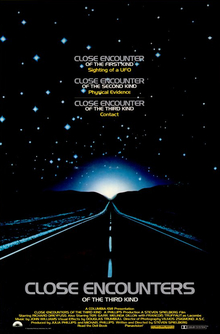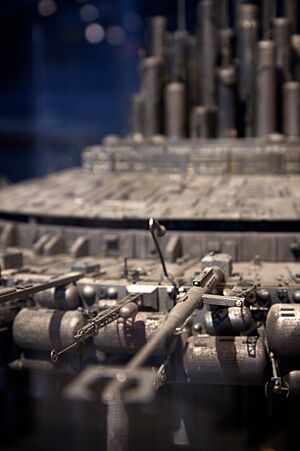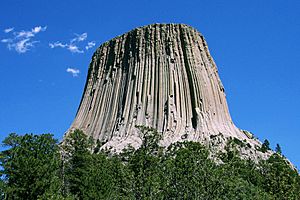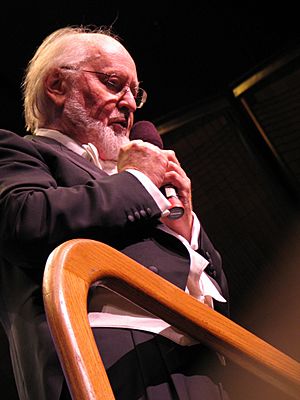Close Encounters of the Third Kind facts for kids
Quick facts for kids Close Encountersof the Third Kind |
|
|---|---|

Theatrical release poster
|
|
| Directed by | Steven Spielberg |
| Produced by | |
| Written by | Steven Spielberg |
| Starring | |
| Music by | John Williams |
| Cinematography | Vilmos Zsigmond |
| Editing by | Michael Kahn |
| Studio |
|
| Distributed by | Columbia Pictures |
| Release date(s) | November 16, 1977 |
| Running time | 135 minutes (Theatrical Version) 132 minutes (Special Edition) 137 minutes (Director's Cut) |
| Country | United States |
| Language | English |
| Budget | $19.4 million |
| Money made | $306.1 million |
Close Encounters of the Third Kind is a classic science fiction film from 1977. It was written and directed by the famous filmmaker Steven Spielberg. The movie stars Richard Dreyfuss, Melinda Dillon, Teri Garr, and François Truffaut.
The story is about Roy Neary, an ordinary worker from Indiana. His life changes completely after he sees an unidentified flying object (UFO). The movie's title comes from a way that experts who study UFOs, called Ufologists, classify meetings with aliens. A "close encounter of the third kind" means a person has seen aliens or living beings from another world.
Close Encounters was a project Steven Spielberg really wanted to make for a long time. It cost about $20 million to produce. The film was first shown in a few cities in November 1977. Later, it was released everywhere. It became a huge success, earning over $300 million around the world.
In 2007, the United States Library of Congress chose Close Encounters to be saved in the National Film Registry. This means it's considered very important for culture, history, or art. A special version of the film, with extra scenes, was released in theaters in 1980. Another version came out in 1998 on VHS and LaserDisc, and later on DVD and Blu-ray. For its 40th anniversary, the film was updated to 4K and re-released in theaters on September 1, 2017.
Contents
Making the Movie: How it was Filmed
Filming for Close Encounters started on May 16, 1976. Director Steven Spielberg first wanted to film everything indoors on special sets. This was because he had a tough time filming his previous movie, Jaws, outdoors. But he eventually decided to film in real places too.
Filming Locations and Special Effects
Devils Tower in Wyoming was a key location used in the movie. The special effects for the film were supervised by Douglas Trumbull. The aliens were designed by Carlo Rambaldi. Douglas Trumbull even joked that the $3.3 million budget for special effects was enough to make another whole movie! Their work helped create new ways to film using motion control photography. This is a technique where cameras move precisely to create special effects.
The large alien spaceship, called the mother ship, was designed by Ralph McQuarrie. It was built by Greg Jein. Steven Spielberg got the idea for the ship's look from an oil refinery he saw at night in India. Instead of looking like metal, the UFOs were designed to glow. One of the UFO models was actually an oxygen mask with lights on it, chosen because of its unusual shape.
As a fun secret, Dennis Muren, who had just worked on Star Wars, put a tiny R2-D2 model on the underside of the mother ship. You can now see the model of the mother ship at the Smithsonian Institution's Air and Space Museum in Virginia.
The small aliens seen at the end of the movie were played by local girls. Spielberg chose girls because he felt they moved more gracefully than boys. They tried using puppets for the aliens, but it didn't work well for most of them. However, two aliens were successfully made with puppets. One was a marionette for the tall alien that first comes out of the mother ship. The other was a puppet that could move its parts, used for the alien that talks with hand signals.
The movie was finished by June 1977. This was too late for it to be a big summer movie, which might have been a good thing, as Star Wars came out that same summer!
Music of the Movie
The music for Close Encounters was created by the famous composer John Williams. He also conducted the orchestra. Williams wrote over 300 different versions of the movie's famous five-note tune. This five-note musical pattern is used by the scientists in the film to talk with the alien spaceship. It's like a special mathematical language they use to communicate. Spielberg picked the perfect tune that became the movie's signature theme.
Movie Themes and Impact
Close Encounters suggests that humans are ready to join other beings in the universe. While a computer helps with the final musical conversation with the aliens, the main character, Roy Neary, is guided by human qualities, not just technology. The movie also shows new technologies as a natural and good part of human growth.
Legacy and Influence
Close Encounters, along with Star Wars and Superman, helped bring back the popularity of science fiction films. In 1985, Steven Spielberg gave $100,000 to The Planetary Society to help with the Megachannel ExtraTerrestrial Assay. This project aimed to listen for signals from space.
In 2011, the ABC channel aired a special show called Best in Film: The Greatest Movies of Our Time. This show ranked the best movies chosen by fans. Close Encounters of the Third Kind was picked as the #5 Best Sci-Fi Film.
Images for kids
-
Devils Tower in Wyoming was used as a filming location.
-
Visual effects miniature model on display at the Smithsonian's National Air and Space Museum.
See also
 In Spanish: Close Encounters of the Third Kind para niños
In Spanish: Close Encounters of the Third Kind para niños






